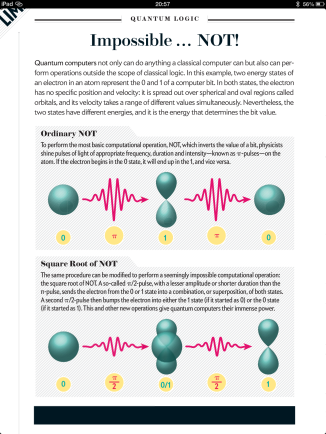Archivos Mensuales: octubre 2012
A New iPad? – csectioncomics.com
Square Root of NOT — Impossible Not #QuantumLogic #SciAm
Don’t Believe People Who Say They Work 60 Hours a Week
Don’t Believe People Who Say They Work 60 Hours a Week
Don’t Believe People Who Say They Work 60 Hours a Week People overstate the number of weekly hours they «usually» work by 5% to 10%, with those on the higher end being more likely to overestimate, according to a study led by John P. Robinson of the University of Maryland. By examining U.S. workers’ time diaries, the researchers found that people who say they usually work 55 to 64 hours per week are off by an average of about 10 hours; people who say they work 65 to 74 hours are overstating by about 20 hours. Respondents may inflate their estimates because of a desire to appear industrious, the researchers suggest. Source: The overestimated workweek revisited
The real value of fans’ behavior during a game
Performance Review
Errors should never pass silently
The potential ROI from 15 minutes conversation a day? – TakeON!
The potential ROI from 15 minutes conversation a day?
A couple of weeks ago I spoke at the New Zealand 2012 Continuous Improvement Conference run by CI Forum. The conference was attended by a couple of hundred CI practitioners – mainly Lean or Six Sigma specialists, and I had been asked to keynote on ‘leader-led communication to drive engagement
‘.
Of course, the role of employee communication as a strategic management tool is not new: it can be traced back over 30 years, when Thomas Gilbert wrote Human Competence. Gilbert stated unequivocally that employees need to talk about where the business is going. Applying his ideas to real work situations, Gilbert concluded that simply by improving the communication of information to employees, performance could be improved by between 20-50%.
Never has that point been illustrated to me more clearly than by the case study that followed my keynote. In it, Tim Denison from the Auckland District Health Board explained how, through introducing a daily 15 minute meeting (called Daily Rapid Rounds) to review patients on the Ward, savings of over $3.5m per annum have been achieved in just the General Medicine and Orthopedics Wards alone!
It provides clear insight of the value that comes from embedding the right kind of simple, conversation-based routines within teams. My very rough, back of the envelope calculation suggest that Daily Rapid Rounds is delivering an ROI of around 2,500% per annum.
It also highlights the power of looking at the end-to-end customer journey.
Their big issue – one with enormous consequences.
Their starting point was the front end of their ‘customer’ (patient) journey – achieving quality in Emergency Departments. The ‘issue’ was one of long waits and overcrowding in Emergency Departments.
For example, even after people had been seen and the doctor had decided they should be admitted, the patients were having to wait a further 8 hours (on average) before making it into a bed on the Ward.
Evaluated against a core value of ‘Valuing our Patient’s Time’, that was very off-brand. The challenge was to improve that.
Why were they suffering delays?
Actually, it was very little to do with the Emergency Department process; rather it was simply the case that no beds were available in the Wards (a problem known as Bed Block). It was simply a case of having to wait until someone else was discharged and bed became free.
Naturally, the causal analysis of the process quickly shifted to see if gains could be made in reducing Bed Block. An area of inefficiency or wastage quickly became apparent: the elapsed time from the moment the patient was told they could go home to the time they left.
Front line employees’ stories reveal root causes – and point the way to solutions.
Tim explained how they had actively involved the employees to explore and unlock the issues, and shape the solution. They shared patient and staff stories. Some anecdotes that Tim provided really illustrated the point.
Patient: “The doctor told me I could go home 3 days ago, why am I still here?”
Occupational Therapist: “I get too many late referrals, it’s hard to organise equipment on a patient’s discharge day”.
Charge Nurse: “I spend up to 4 hours a day chasing different team members to coordinate our patients’ plans and estimated discharge date”.
In essence, getting patient out the door often involves some cross-functional coordination and planning. When left simply to clinical notes (those clip boards at the end of the bed), and ad hoc face-to-face meetings, that’s hard to achieve.
In order to arrive at a better process, the change team also:
• Used clinical champions to lead the process
• Found and shared examples from other health care organisations
• Involved range of staff in solution idea sessions
• Piloted the solution first.
A simple conversation process with spectacular results
The major process change was the seemingly simple idea of introducing the ‘Daily Rapid Round’. This is a daily 15 minute stand up meeting involving the doctor, charge nurse, staff nurse, physio, occupational therapist and social worker, using an electronic screen.
The status of each patient on the Ward is quickly reviewed against four agenda items: Change to working diagnosis; Plan for the day/stay; Referral status; Estimated discharge date. The process is also supported by visual management – with the large status board for patients visible in the work area.
Communication, clarification, collaboration, and co-ordination!
The results are spectacular……
Over 6,000 bed nights per annum have been freed up in General Medicine and Orthopaedics, (at a cost of $3.5m) And back at the front-end of the patient journey where the log-jam was occurring?
The average ‘admission’ time has fallen from 8 hours to 1 hour 15 minutes.
An ‘on-brand’ outcome for all parties. Patients are waiting for much less time at both ends of the journey, the health professionals feel like they are using their time more productively and delivery higher standards of patient care and, the hospital administrators are seeing a higher ROI.
All resulting from a structured conversation, which brings people together.






